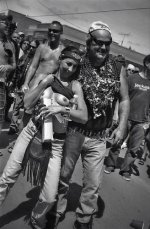airfrogusmc
Veteran
@airfrogusmc
Re: your shot
I find your photograph interesting, although on its own not very powerful. My personal preference would be to cut away a piece of the stripes on the right, to lighten their impact and draw the attention to the center-left of the image, where the more important things are happening. I disagree with the comments, that the photo is weak, and the reflections not strong enough, etc. There is an interesting aesthetics, and that on its own can be sufficient for someone to write a cheque for over 4 million USD, like in case of Rhine II, which as a stand alone photograph is worth as much as the printing paper it has been made on. On a more personal note - I dislike the digital look of your photos, but this is my personal thing. I like Jazz and usually am bored by pop music as well.
My shot is just a street photo with no particular acrobatic-geometric effects or historic importance. It is interesting for me, because I am concerned with the individual, her/his problems and thought processes, and a handsome candid moment of solitary reflection is good enough for me to press the shutter. This was shot in Cannes - was this girl French or maybe Russian? Was she texting with her Monaco boyfriend, or was she upset, because her brother was on the Ukrainian front? Only she knows, like only YOU know what is going on in your head now. Not everybody needs to be Cartier-Bresson or Constantine Manos, who BTW for me is one of the best colour photographers I know about.
What I find compelling about your shot is there is a drink in front of her and there is an espresso cup on the other side of the table and now for the real kicker is the guy in the door window coming out. Is he the other person that was at the table drinking espresso and smoking? Who is she texting? And the background is a bit busy but I don't find it overly distracting and maybe necessary because there is a guy that is turning his head back into the frame and that keeps the flow from continuing out of the frame. Nicely done. Probably fits in very nicely in a larger body of work.
I love jazz to but I love the fact I can get med format quality from my MM even at high ISO. When a younger man I shot street occasionally with a 500 C/M and loved the clarity of the larger files and if I were so inclined which I am not I could always degrade the images and add grain and such or go back to shooting 35mm film.
I like Mano's work to and I really like Meyerowitz's color street work.




